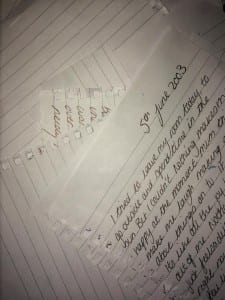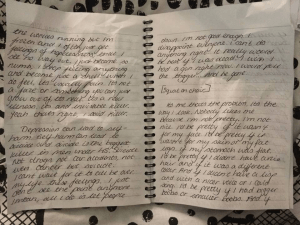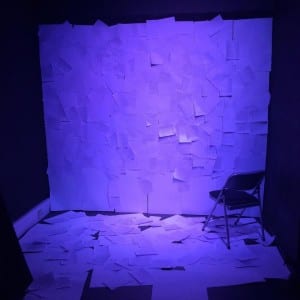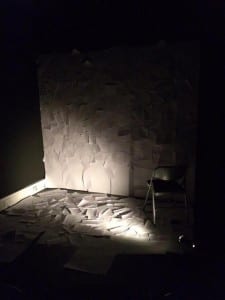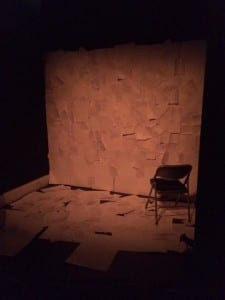This is going to be a long post so bare with…
Yesterday was the day of my performance. It’s done.
Background and Set
Admittedly not everything went the way I originally would’ve liked.
Due to personal circumstances , lack of blue tac and time I was unable to create the backdrop I had imagines in my head. However, that isn’t to say that I didn’t create a set that still gave the impression and sense of entrapment that I had wanted. I only covered one wall of the alcove with paper and then scattered paper all over the floor. Having only one wall of the alcove covered meant that the other two were still completely black creating even more of an enclosed feeling than if all the walls were covered in the paper. Some of my audience members even commented that this is what they felt.
Apart from the bits of paper, the only other thing in the alcove was a chair. The chair was a plain grey metal one, one that is used during normal university seminars and workshops and the exact same kind as the audience were sat on. This was intentional so that the audience felt as though they were in the performance as well as me. They were sitting on the same chair as the performer and therefore it related to them slightly through this.
Pages
It took me many days to write all the diary entries that were used. They were all handwritten and by the day of the performance there was 226. They consisted of actual diary entries of those who are suffering or have suffered from Depression or Anxiety, quotes from the interviews I had conducted and also some accounts from online.
For the performance I wanted these written on pieces of paper to cover every inch of the wall however, I decided on using some blank pieces of paper too to add a little more dimension to the piece and to make it look like the audience and myself were indeed in the pages of a book, the book and the story being unfinished.
Book
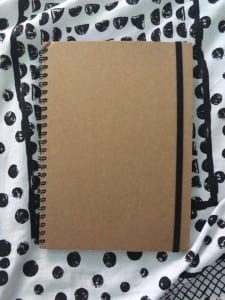 Throughout the creative process I had always said that although I want the piece to be aesthetically stunning I want the focus to be on the words that I speak. Therefore I decided on taking a notebook on stage with me. This has been an option throughout the design of my show. I had three options: To learn my entire monologue and perform it without the aid of a script (which in hindsight may have been the better choice), have the lines written on separate ‘diary entries’ scattered around the performance space so that I could read from these, or have them in a notepad. I opted for the latter option and there are reasons for this choice. I had learnt my lines and I did know the majority of them however, due to the amount of movement and character changes during the piece there was a risk that I would say the wrong lines for the wrong character and that would have been confusing for the audience, but also in my script I mention the depressive mind being like a crewed up piece of paper in a book.
Throughout the creative process I had always said that although I want the piece to be aesthetically stunning I want the focus to be on the words that I speak. Therefore I decided on taking a notebook on stage with me. This has been an option throughout the design of my show. I had three options: To learn my entire monologue and perform it without the aid of a script (which in hindsight may have been the better choice), have the lines written on separate ‘diary entries’ scattered around the performance space so that I could read from these, or have them in a notepad. I opted for the latter option and there are reasons for this choice. I had learnt my lines and I did know the majority of them however, due to the amount of movement and character changes during the piece there was a risk that I would say the wrong lines for the wrong character and that would have been confusing for the audience, but also in my script I mention the depressive mind being like a crewed up piece of paper in a book.
I also thought that this was another way of making the audience feel like they were sat in a depressed persons mind or diary, the pages bleeding out into the audiences space and therefore the book represented the actual diary that they were in.
As I say, in hindsight I am not sure that this worked aesthetically and I am unsure whether this was obvious enough to the audience. I found that I ended up reading from the book more than I needed to which maybe made the piece feel uninteresting and removed the personal element from the show.
Characters
In total there were 6 different voices in my piece. I represented all of these through the use of body language and positioning on the stage and only one is gender specific. Having none gender specific characters means that the piece can be relatable to everyone, there are lines throughout the show that are about the way a female looks and what contributes to a females depression but there are also a few lines and statistics that relates to male depression.
C1 – Manic Depressive. Crouched on the floor in the corner of the stage in a little ball. Slow with their speech.
C2 – Open about their depression. Quite young body language and tone of voice. Standing centre stage.
C3 – Depression is new to them and they are coming to terms with having it and what this means for them. In a ball on the chair facing the wall.
C4 – A doctor-like figure/Therapist. Someone there to give facts and the ‘other’ views from the perspective of those who do not suffer from Depression. Sat on the chair facing the audience, back straight and formal in voice.
C5 – A relative of someone who has committed suicide. Sad and lost. Standing again centre stage but more within the audience/closer to the audience.
Me – As myself to give the last lines.
There are reasons why I chose the areas of the stage for these voices and the body language that they are performed with. Character 1 for example is a manic depressive, they’re the character that at the end of the story talks of ways to kill themselves. They are crouched in a corner, in a small ball as if to protect themselves.
Character 2 is open about their depression therefore they are standing in the middle of the stage in full view of the audience, open and willing.
Character 3 are in a ball on a chair, coming to terms with something they don’t yet understand. They are facing the back wall, away from the audience because they’re withheld about it, embarrassed to say they have a problem.
I performed Character 4 n a very feminine manner to appear as the stereotypical “calming female”. Quite a formal character with a posh high voice and a straight back, this character was exaggerated to be completely different to the others so as to separate what she was saying more.
Character 5 only has a few lines at the end and came out more to the audience to represent one of them, the people who do not have a mental illness but may know someone with one. This character was still fairly distant with the audience as to be singled out.
Recordings
The recordings were created to break the piece up and represent thoughts. They were harsh and quite hard hitting to capture the harshness of a persons self-criticism. They were written in third person. My audience admitted they instantly understood these were someone’s thoughts and feelings about themselves and said that these little clips contributed heavily to their overall mood after leaving the performance.
As I wrote in a previous post about my tech rehearsal, I recorded each clip in an echoey room in order for them to appear slightly distorted again to break away from the voice of a living person.
Here is one of the recordings:
Tech
I had different lighting states for different characters to help the audience to differentiate each character.
As the audience walked in and sat down the light was a strong blue/purple and in all honesty, the colour was picked because I liked it. It was striking and different from the rest of the lights within the show. The colour blue is cold and sad and mixed with purple I felt it just looked nice.
Character 1’s light was from a birdy. This was the only light and was focused on the corner like a spotlight, this created some really nice shadows when I sat there and creates a sense of entrapment and loneliness.
Character 2’s light was a pale pink colour. Just a tint with the lights quite bright and clear.
Character 3’s lighting state was a spotlight on the chair with no other lights on. Again like Character 1’s light it gave a sense of entrapment and loneliness but also focus.
Character 4’s light was a ‘cream’ yellow light to represent the cleanliness of a hospital/doctors, and clearness of a healthy persons mind.
Character 5’s light was the same as the beginning when the audience walked in, a dark and sad colour.
When the recordings came on the light on the stage was dull making the person on stage distorted. I did this because I wanted all focus to be on what was being said in the recordings, what was happening on stage wasn’t important.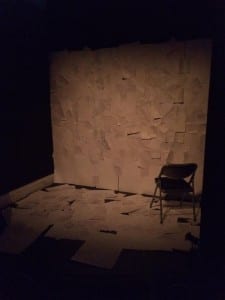
Script
The script consisted of quotes from online articles and websites about depression, suicide and self-harm as well as lines taken from interviews I had conducted. The first draft of the script was 7 minutes long, the second draft somehow gained 10 minutes more becoming 17minutes long, however the third draft was cut down to 11 minutes including short pauses for tech. During the actual performance the show seemed like it went on for a lot longer than 12 minutes though I am unsure how long exactly it was. The piece was heavy and for this reason I didn’t want the performance to overrun so I hope it didn’t run over too much.
Audience
My audience was capped at 20 people because of the space I had chosen to do it in and I had them sat in a semi-circle around the alcove. I had a sold out show which meant that every chair was filled. Throughout the performance I made sure to look at each member, to invite them in, in the hope that the more they feel a part of the performance, the more they will take away from it. I was fortunate enough to make an audience member cry which means that the piece affected her. The aim of the whole performance was to help people understand how someone with a mental illness (such as depression) thinks and believes. I wanted the audience to feel overwhelmed and sad and leave thinking about what they had just seen and talking about the illness, spreading awareness.
Artist Influences Explained
So I was influenced by David Cale, Karen Finley, Spalding Grey, Anna Deavere Smith and Sarah Jones. I took elements of their work to create my own show. Cale and Grey’s storytelling techniques and Finley’s iconic expression and performance of taboo subjects within the theatre but also new artists such as Smith and Jones who’s own performances are similar to my own. I actually found these two artists after I had devised my piece however, I looked to them for some confidence in the show I was going to perform and became inspired by their ease.
Conclusion
Although this performance did not go how I had originally intended the meaning and emotion that I wanted to convey was able to come through and the feedback from my audience was positive. If I was to do it again I would probably take away a lot from the script in order to make sure I stuck to the time allowed for my performance and also make sure that I had enough time to create the set exactly how I wanted it. I am happy with how the performance went though and would gladly do another solo performance, maybe exploring other mental illnesses. Simplicity was key in my performance, it was just me and a chair on stage, Yes there was a few changes of the light and the switching of character to character may have got confusing at times (which was my biggest worry so hopefully it didn’t) but what I was saying was, for me, the important part of the piece.

